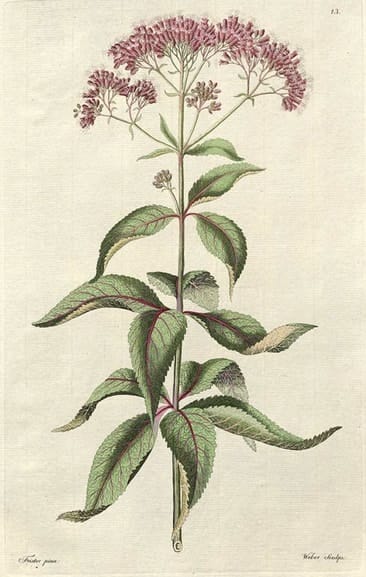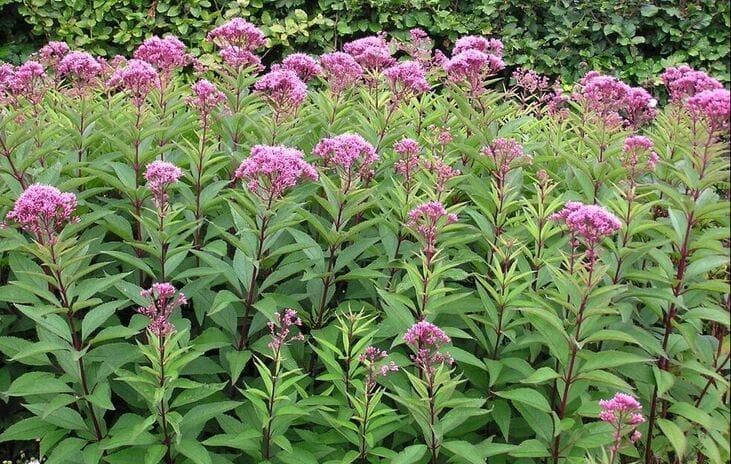Eupatorium purpureum, Queen of the Meadow
Gravel root, Joe Pye Weed, Purple Joe Pye Weed, Kidney Root, Gravel Root, Fever Weed, Trumpet Weed, Purple Boneset Eupatorium purpureum
Eupatorium purpureumThesaurus Botanicus (1805-1819), Trattinnick
 Eupatorium purpureum
Eupatorium purpureum(Photo by A. Barra) (Wikimedia)
Botanical name:
Eupatorium purpureum (syn. E. falcatum, Eutrochium purpureum, Cunigunda purpurea, Eupatoriadelphus purpureus)
E. maculatum, E. fistulosum E. verticillatum are said to have similar properties.
Parts used:
Root; also the leaves
Temperature & Taste:
Cool, dry.
Uses:
1. Clears Heat and Damp, Promotes Urine:
-Edema, Gravel
-scanty high-colored urine with Fever and back pain
-bladder irritability with constant desire to urinate
-painful or bloody urination
-chronic Nephritis, albuminuria
-Prostatitis
2. Astringes Kidneys, Stops Leakage:
-Childhood Incontinence with irritation
-Incontinence in Pregnancy
-Spermatorrhea with Heat and Damp
3. Clears Wind-Damp:
-acute Rheumatism and Arthritic complaints
-Lumbago
-this effect is mild so is combined with other suitable herbs
4. Moves the Blood, Regulates Menstruation:
-Amenorrhea, Leukorrhea (internally or as a douche) (Cook, Felter & Lloyd)
-Uterine Prolapse
-Threatened Miscarriage
5. Stops Cough and Wheezing:
–chronic Cough, Asthma, Whooping Cough (Cook, Felter & Lloyd)
–chronic catarrh
Dose:
Powder: 2–4 grams, 2 or 3 times daily
Infusion: half ounce in a pint of boiling water: 1 fluid ounce every 2 hours in acute cases; 2 fluid ounces 2–4 times daily in chronic cases.
Decoction: 1 oz. in one and a half pints, boiled down to 1 pint: 1–4 oz. as a dose.
Fresh Plant Tincture (1:2 in 95% alcohol): 1–60 drops (Childhood Incontinence, 5 drops three times daily; Incontinence of Pregnancy 1–2 drops every 2–3 hours)
Dry Plant Tincture (1:5 in 60% alcohol): 1–3 mls.

Main Combinations:
1. Edema:
i. Queen of the Meadow with Carrot seed
ii. Queen of the Meadow with Horseradish root, Juniper berry
2. Bladder irritability with constant desire to urinate:
i. Queen of the Meadow, Marshmallow
ii. Queen of the Meadow, Couch Grass
iii. Queen of the Meadow, Golden seal, Burdock seed
3. Gravel, Stones:
i, Queen of the Meadow with Corn Silk, Collinsonia, Viburnum
ii, Queen of the Meadow with Horsetail, Couch Grass, Hydrangea, Parsley Piert
iii, Queen of the Meadow with Carrot seed, Meadowsweet, Marshmallow, Bearberry
iv. Queen of the Meadow with Madder, Horsetail, Pellitory of the Wall, Dandelion, Couch Grass
v. pain from Gravel and Uric acid, Queen of the Meadow with Hydrangea
4. Dysuria, Cloudy or high-colored Urine, Queen of the Meadow with Agrimony
5. Hematuria, Queen of the Meadow with Shepherd’s Purse
6. Nephritis:
i. Queen of the Meadow with Comfrey root as a decoction (Dr. Christopher)
ii. Queen of the Meadow with Bearberry, Buchu
7. Rheumatism, Arthritis:
i. Queen of the Meadow with Celery seed, Guaiacum, Couch Grass
ii. Queen of the Meadow with Wormwood, Oak bark, Comfrey root, Marshmallow root, Lobelia, Black Walnut bark or leaf, Mullein, Scullcap (as in the formula ‘Bone, Flesh and Cartilage’ of Dr. Christopher)
8. Bedwetting or Incontinence, Queen of the Meadow with Parsley root, Juniper berry, Marshmallow root
9. Prostate disorders:
i. Queen of the Meadow with Willow Herb, Saw Palmetto
ii. with pelvic pain, Queen of the Meadow with Black Cohosh
iii. Queen of the Meadow with Golden Seal, Juniper berry, Marshmallow root, Parsley root
Major Formulas:
Cautions:
None noted.
However, as it contains pyrrolizidine alkaloids, it should be avoided in those with Liver disease and should not be used long-term.
Main Preparations used:
Tincture
